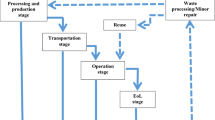Abstract
The building sector offers significant opportunities for reducing the energy consumption with considerable economic, environmental and health benefits. Governments can lead the way by retrofitting existing public buildings to reinforce their commitment to improve energy efficiency. Similar design standards, end-uses and operational profiles are usually established for public buildings based on the services they offer. Retrofitting a public building can therefore serve as an ideal test-bed for energy efficiency measures for other buildings within a particular service category. This study first analysed the current electricity consumption of a public office building in Mauritius, located in the Southern Hemisphere. A complete model of the building was created, validated and then simulated to investigate the impact of realistic retrofit strategies on the electricity consumption. Results showed that lighting retrofit achieved the most significant reduction while measures that improved the thermal envelope of the building resulted in smaller energy savings. The possibility of exploiting solar energy was explored by simulating a 70 kWp photovoltaic system installed on the roof. An equivalent of 8.5% of the annual electricity consumption of the building could thus be generated. A financial analysis is also presented for all retrofit scenarios in terms of annual return and payback period.
Similar content being viewed by others
References
Allcott H, Mullainathan S (2010). Behavior and energy policy. Science, 327: 1204–1205.
Ardente F, Beccali M, Cellura M, Mistretta M (2011). Energy and environmental benefits in public buildings as a result of retrofit actions. Renewable and Sustainable Energy Reviews, 15: 460–470.
ASHRAE Climatic Design Conditions (2009). Available at http://ashraemeteo.
Central Electricity Board (2014a). Integrated Electricity Plan 2013–2022: Demand Forecast for Mauritius. Available at http://ceb.intnet.mu/CorporateInfo/IEP2013/Chapter4_Demand%20Forecast%20for %20 Mauritius.pdf. Accessed 15 Dec. 2014.
Central Electricity Board (2014b). Commercial Tariff. Available at http://ceb.intnet.mu/tariffs/commercial.asp. Accessed 28 Dec. 2014.
CIBSE (2006). CIBSE Guide A: Environmental design. Chartered Institution of Building Services Engineers.
CIBSE (2012). CIBSE Guide F: Energy Efficiency in Buildings. Chartered Institution of Building Services Engineers.
Chidiac SE, Catania EJ, Morofsky E, Foo S (2011). Effectiveness of single and multiple energy retrofit measures on the energy consumption of office buildings. Energy, 36: 5037–5052.
Chirarattananon S, Taweekun J (2003). A technical review of energy conservation programs for commercial and government buildings in Thailand. Energy Conversion and Management, 44: 743–762.
Chow DH, Zhilei Li, Darkwa J (2013). The effectiveness of retrofitting existing public buildings in face of future climate change in the hot summer cold winter region of China. Energy and Buildings, 57: 176–186.
Fiaschi D, Badinelli R, Conti S (2012). A case study for energy issues of public buildings and utilities in a small municipality: Investigation of possible improvements and integration of renewables. Applied Energy, 97: 101–114.
Hestnes AG, Kofoed NU (2002). Elective retrofitting scenarios for energy efficiency and comfort: Results of the design and evaluation activities within the OFFICE project. Building and Environment, 37: 569–574.
Jain RK, Taylor JE, Culligan PJ (2013). Investigating the impact ecofeedback information representation has on building occupant energy consumption behavior and savings. Energy and Buildings, 64: 408–414.
Kalz D, Herkel S, Sonntag M, Pfafferott J (2014). Energy efficient cooling and thermal comfort for office buildings—long-term monitoring in 42 buildings. Bauphysik, 36: 221–235.
Kang SM, Seager R, Frierson DMW, Liu X (2015). Croll Revisited: Why is the northern hemisphere warmer than the southern hemisphere? Climate Dynamics, 44: 1457–1472.
Kim D (2010). Optimizing cost effective energy conservation measures for building envelope. Energy Engineering, 107 (3): 70–80.
Li JS (2008). A study of energy performance and efficiency improvement procedures of government offices in Hong Kong Special Administrative Region. Energy and Buildings, 40: 1872–1875.
Ma Z, Cooper P, Daly D, Ledo L (2012). Existing building retrofits: Methodology and state-of-the-art. Energy and Buildings, 55: 889–902.
Mauritius Meteorological Services (2014). Climate of Mauritius. Available at http://metservice.intnet.mu/climate-services/climateof-mauritius.php. Accessed 16 Dec. 2014.
McKinsey and Company (2009). Pathways to a Low Carbon Economy: Version 2 of the Global Greenhouse Gas Abatement Cost Curve. Available at https://solutions.mckinsey.com/Climate Desk/default. aspx. Accessed 27 Dec. 2014.
Mososo OT, Grobler LJ (2010). The dark side of occupants’ behaviour on building energy use. Energy and Buildings, 42: 173–177.
Pisello AL, Asdrubali F (2014). Human-based energy retrofits in residential buildings: A cost-effective alternative to traditional physical strategies. Applied Energy, 133: 224–235.
Statistics Mauritius (2014). Population and vital statistics: Republic of Mauritius. Available at http://statsmauritius.govmu.org/English/StatsbySubj/Pages/Population-Jan-June-2014.aspx. Accessed 05 Dec. 2015.
UNEP (2009). Buildings and Climate: Summary for Decision-Makers. United Nations Environment Programme Sustainable Buildings & Climate Initiative. Available at http://www.unep.org/sbci/pdfs/sbci-bccsummary.pdf. Accessed 22 Dec. 2014.
University of Cambridge (2014). Energy modelling and building physics resource base: IES Virtual Environment. Available at http://wwwembp. eng.cam.ac.uk/software/iesve. Accessed 15 Dec. 2014.
Wade J, Pett J, Ramsay L (2003). Energy Efficiency in Offices: Assessing the Situation. London: The Association for the Conservation of Energy.
Author information
Authors and Affiliations
Corresponding author
Rights and permissions
About this article
Cite this article
Oree, V., Khoodaruth, A. & Teemul, H. A case study for the evaluation of realistic energy retrofit strategies for public office buildings in the Southern Hemisphere. Build. Simul. 9, 113–125 (2016). https://doi.org/10.1007/s12273-015-0259-y
Received:
Revised:
Accepted:
Published:
Issue Date:
DOI: https://doi.org/10.1007/s12273-015-0259-y




